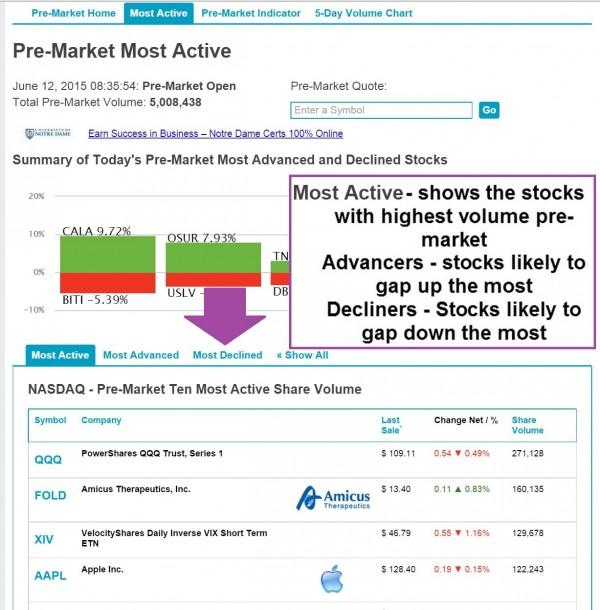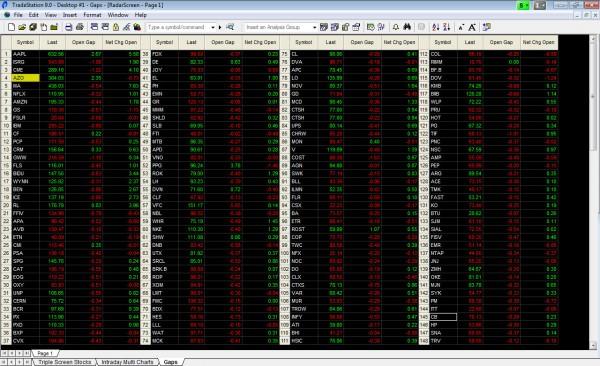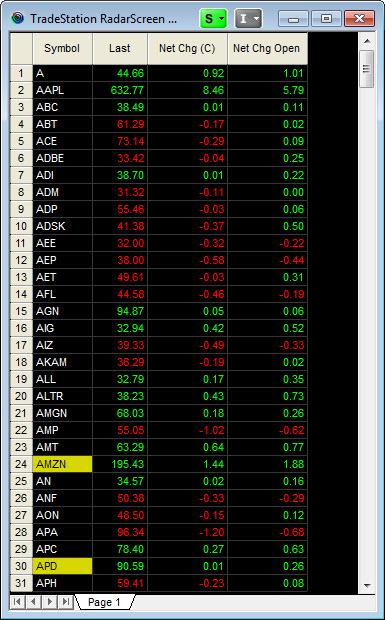Those of you who have been in my live classes or XLT sessions know that I like to trade the morning gaps. This is a period of high volatility and price movement that can offer great opportunities when traded properly. Of course, with the increased volatility comes greater risk and you should not trade this time unless you have a detailed plan on how to trade it that also includes risk management rules.
When I used to work as a trader for a retail brokerage, I learned first-hand that gaps were caused from a large imbalance between buyers and sellers. This imbalance could be the result of news on the company or sector or an economic data release that changes investor sentiment. The retail traders either place orders in the after-hours markets or they have them stack up for the brokers to fill on the open.
The broker’s traders and market makers generate income for their companies and themselves by filling customer orders. When there is a large imbalance between buyers and sellers due to an influx of one stack of orders from retail customers reacting to news, they cannot fill those orders until they find enough pending orders on the opposite side, (i.e., sell orders to match their customers’ buy orders). Prior to the open of the markets at 9:30am EST, the market makers will push prices higher or lower so that when price gaps open, it will open into an opposing supply or demand zone with orders to fill their customers’ ones.
As a trader, we can locate stocks that are likely to gap up into supply or down into demand so that we can take advantage of this novice trading. The key is to know where to look. One thing to remember is that even though the pre-market information may be showing a potential gap, it doesn’t mean it will happen. There have been several times where the gap failed to materialize even after the data showed it should.
A free source for gapping information is the NASDAQ itself. On the home page of the NASDAQ website, www.nasdaq.com, there is a section for the pre-market. By looking at the leaders in the pre-market, we can identify which stocks may gap up or down. Based on where the broad market is opening, this information can be used for excellent trades in the morning.
If you are looking for more options other than just the NASDAQ, then you can rely on your trading platform. I use TradeStation which allows me to screen for gapping stocks on their radar screen. When the market opens, the column heading “Open Gap” shows me how much a stock gapped up or down. When I compare this to the “Net Change Open” column, I can see if that stock is trying to fill the gap. You can populate this scanner with any list of stocks you would like; and by clicking on the header you can sort by gaps up or down.
Using another analysis technique called “Net Chg (C)” can also be useful. This will show you the change in price from the prior day’s close and can help you to identify stocks likely to gap before they open.
Whichever method you choose to identify the stocks likely to gap, exercise caution in trading them. Gap trading and even trading in general in the first 15 minutes of the trading day can be dangerous and should only be undertaken by experienced traders who also have a solid plan for doing so. Once mastered, this type of trading has good potential for quick profits.
Neither Freedom Management Partners nor any of its personnel are registered broker-dealers or investment advisers. I will mention that I consider certain securities or positions to be good candidates for the types of strategies we are discussing or illustrating. Because I consider the securities or positions appropriate to the discussion or for illustration purposes does not mean that I am telling you to trade the strategies or securities. Keep in mind that we are not providing you with recommendations or personalized advice about your trading activities. The information we are providing is not tailored to any individual. Any mention of a particular security is not a recommendation to buy, sell, or hold that or any other security or a suggestion that it is suitable for any specific person. Keep in mind that all trading involves a risk of loss, and this will always be the situation, regardless of whether we are discussing strategies that are intended to limit risk. Also, Freedom Management Partners’ personnel are not subject to trading restrictions. I and others at Freedom Management Partners could have a position in a security or initiate a position in a security at any time.
Editors’ Picks
AUD/USD dips below 0.6600 following RBA’s decision

The Australian Dollar registered losses of around 0.42% against the US Dollar on Tuesday, following the RBA's monetary policy decision to keep rates unchanged. However, it was perceived as a dovish decision. As Wednesday's Asian session began, the AUD/USD trades near 0.6591.
EUR/USD edges lower to near 1.0750 after hawkish remarks from a Fed official

EUR/USD extends its losses for the second successive session, trading around 1.0750 during the Asian session on Wednesday. The US Dollar gains ground due to the expectations of the Federal Reserve’s prolonging higher interest rates.
Gold wanes as US Dollar soars, unfazed by lower US yields

Gold price slipped during the North American session, dropping around 0.4% amid a strong US Dollar and falling US Treasury bond yields. A scarce economic docket in the United States would keep investors focused on Federal Reserve officials during the week after last Friday’s US employment report.
Solana FireDancer validator launches documentation website, SOL price holds 23% weekly gains

Solana network has been sensational since the fourth quarter (Q4) of 2023, making headlines with a series of successful meme coin launches that outperformed their peers.
Living vicariously through rate cut expectations

U.S. stock indexes made gains on Tuesday as concerns about an overheating U.S. economy ease, particularly with incoming economic reports showing data surprises at their most negative levels since February of last year.
RECOMMENDED LESSONS
Making money in forex is easy if you know how the bankers trade!
Discover how to make money in forex is easy if you know how the bankers trade!
5 Forex News Events You Need To Know
In the fast moving world of currency markets, it is extremely important for new traders to know the list of important forex news...
Top 10 Chart Patterns Every Trader Should Know
Chart patterns are one of the most effective trading tools for a trader. They are pure price-action, and form on the basis of underlying buying and...
7 Ways to Avoid Forex Scams
The forex industry is recently seeing more and more scams. Here are 7 ways to avoid losing your money in such scams: Forex scams are becoming frequent. Michael Greenberg reports on luxurious expenses, including a submarine bought from the money taken from forex traders. Here’s another report of a forex fraud. So, how can we avoid falling in such forex scams?
What Are the 10 Fatal Mistakes Traders Make
Trading is exciting. Trading is hard. Trading is extremely hard. Some say that it takes more than 10,000 hours to master. Others believe that trading is the way to quick riches. They might be both wrong. What is important to know that no matter how experienced you are, mistakes will be part of the trading process.




